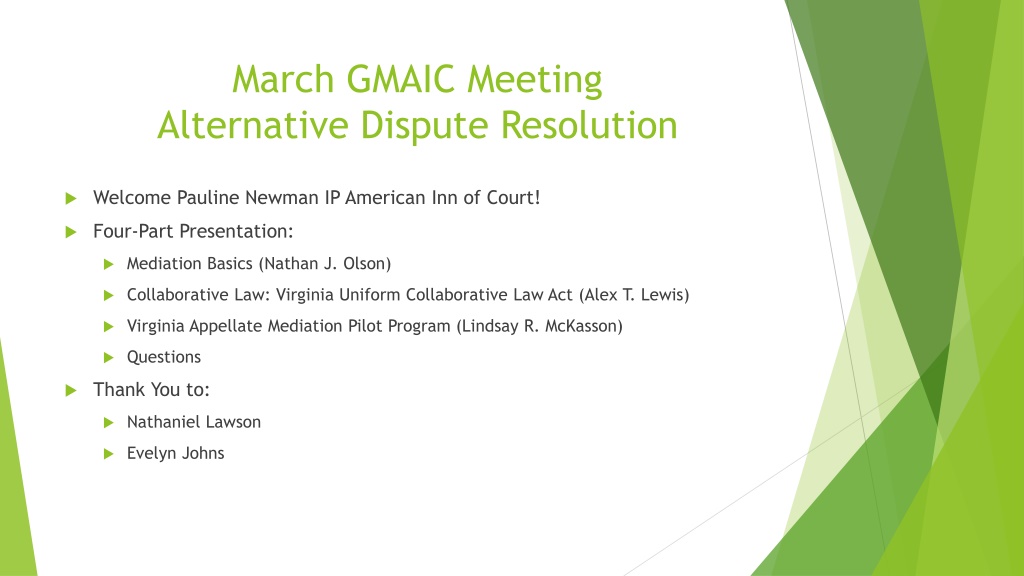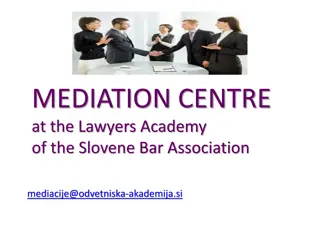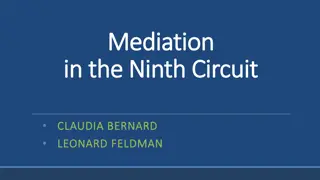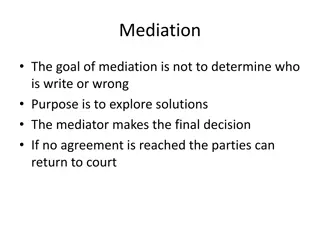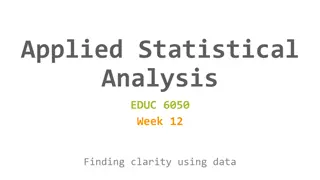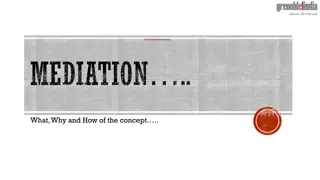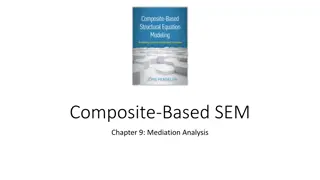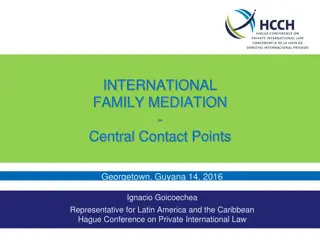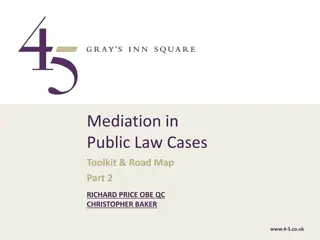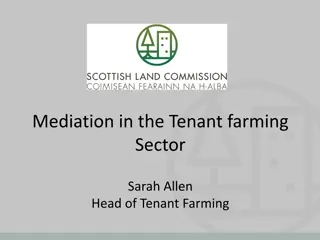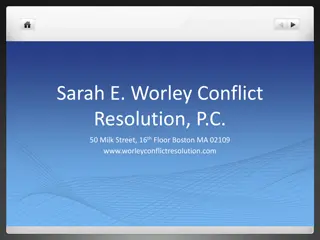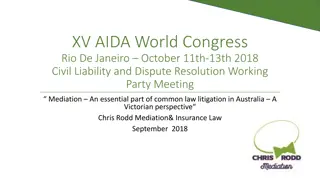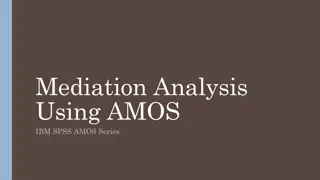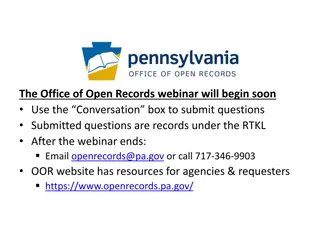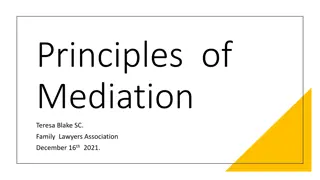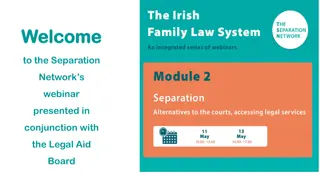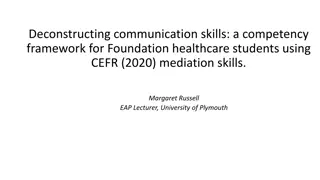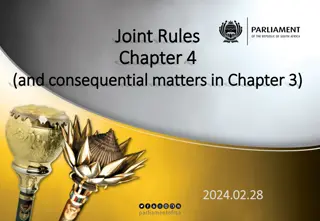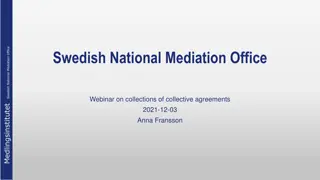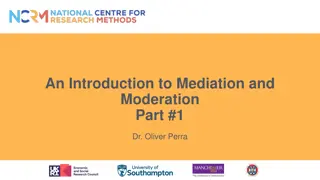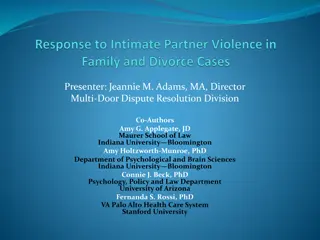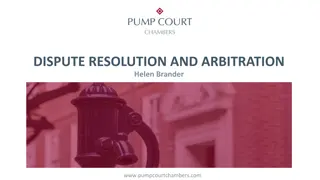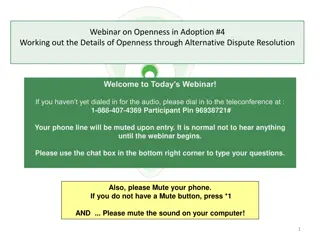Understanding Mediation: Roles, Responsibilities, and Processes
Exploring the concept of mediation in legal proceedings, this text delves into the definitions, roles, and responsibilities of a mediator. It discusses the voluntary and confidential nature of mediation, the qualifications of a mediator, and the steps involved before and after reaching an agreement. Emphasis is placed on maintaining neutrality, facilitating communication, and ensuring parties' understanding and agreement in conflict resolution.
Download Presentation

Please find below an Image/Link to download the presentation.
The content on the website is provided AS IS for your information and personal use only. It may not be sold, licensed, or shared on other websites without obtaining consent from the author. Download presentation by click this link. If you encounter any issues during the download, it is possible that the publisher has removed the file from their server.
E N D
Presentation Transcript
March GMAIC Meeting Alternative Dispute Resolution Welcome Pauline Newman IP American Inn of Court! Four-Part Presentation: Mediation Basics (Nathan J. Olson) Collaborative Law: Virginia Uniform Collaborative Law Act (Alex T. Lewis) Virginia Appellate Mediation Pilot Program (Lindsay R. McKasson) Questions Thank You to: Nathaniel Lawson Evelyn Johns
Mediation: Tips, Strategy, and Advice
What is Mediation? General Definition A voluntary and confidential process in which an impartial third party assists parties in reaching a mutually acceptable solution to their conflict in civil cases. Statutory Definition (Virginia Code Section 8.01-581.21) A process in which a mediator facilitates communication between the parties and, without deciding the issues or imposing a solution on the parties, enables them to understand and to reach a mutually agreeable resolution to their dispute. Virginia Supreme Court Definition Mediation is an alternative dispute resolution (ADR) process in which a trained neutral mediator facilitates communication between the parties and, without deciding the issues or imposing a solution on the parties, enables them to understand and to reach a mutually agreeable resolution to their dispute. It helps the parties understand and recognize their underlying needs, overlapping interests and areas of agreement. In Virginia the mediation process is voluntary and confidential Incorrect Definition: There are many.
Roles and Responsibilities Who is the Mediator? An Individual who has been chosen by the parties or appointed by the Court. There are occasions when there are co-mediators This individual is often, but does not have to be, a retired judge or practicing attorney. State Bar license is not required to mediate in Virginia. In co-mediation cases, often times one of the mediators is an attorney and the other mediator has a different professional background, e.g. mental health professional. This individual is often, but does not have to be, certified by the Supreme Court of Virginia. Certification is not required, so why get certified? Certification: Varying Processes
Roles and Responsibilities Roles of the Mediator (Before Agreement Reached) Explain the mediation process, including its voluntary nature, to the parties. Mediator must remain neutral. No previous connection with the parties or the controversy. No presuppositions about issues or parties. No vested interest in the outcome of the controversy. Determine whether a case is appropriate for mediation. Facilitate a discussion of disputed issues and potential solutions. Assist the parties in memorializing a settlement of any disputed issues. Maintain Confidentiality
Roles and Responsibilities Roles of the Mediator (After Agreement Reached) Review the terms of the agreement. Ensure both parties agree to these terms. Suggest that both parties seek independent legal advice. Draft the agreement? Do you trust that the mediator will draft a comprehensive agreement? Will drafting involve additional charges? Will the mediator work to incorporate any changes that the attorneys suggest for their clients?
What a Mediator Can/Cannot Do Cannot Provide Legal Advice Attorney-mediators may find this challenging, especially those using the Evaluative mediation style Can Provide Legal Information What s the Difference? This is not always clear. Statements declarative of the law are generally permissible. For instance: Guideline child support calculations generally involve four components. Reality-testing questions are commonly used to avoid providing legal advice. Jim, you do realize that the court is going to give Alice a separate equity interest in the marital residence because she used premarital funds for the down payment. (Advice) Have the two of you thought about whether Alice would receive any credit for using her pre-marital funds as a down payment on the marital residence? (Information)
Mediation Styles: Facilitative Original Mediation Style. This is the original style of mediation, and probably what most client will be thinking of mediation when it is first suggested to them. A facilitative mediator is one who literally facilitates the conversation between the parties. This mediation model assumes that the parties are best equipped to find a solution that fits their set of circumstances once they can effectively talk about their circumstances and potential solutions. Facilitative mediators focus on the concept that the parties are making the decisions, and that the mediator is neutral and present primarily to help the parties communicate and exchange information productively. Opportunity to be Heard. A critical component of the communication aspect of facilitative mediation is ensuring that both parties have an opportunity to be heard. Therefore, one goal of a facilitative mediator is to create a safe environment in which the parties can openly discuss their motivations and positions. Open Lines of Communication. Facilitative mediators do not evaluate the parties positions or arguments, and therefore a purely facilitative mediator will not offer opinions as to what the outcome might be in a courtroom. Instead, they focus on maintaining open lines of communication, sharing information, and allowing the parties to reach their own conclusions as to what an appropriate result would look like. Mediation Format. Facilitative mediators tend to favor a mediation format in which the parties are in the same room rather than a caucus format. Also, facilitative mediators lean away from imposing time pressure on the parties, and as a result, are more inclined to schedule a series of mediation sessions rather than one marathon session.
Mediation Styles: Evaluative Opinion. This style of mediation requires the mediator to give his or her opinion regarding the outcome of the case. Most often, the evaluation is a legal analysis of the issues, but depending on the parties, the evaluation could be based on a different standard, e.g. cultural, religious, technical, etc. Differences between Facilitative and Evaluative. The two most significant differences between facilitative and evaluative mediation styles are: The evaluative mediator will provide an opinion as to what the outcome will be; and The evaluative mediator is far more concerned with getting a deal signed than with ensuring that both parties have felt as if they were heard. As a result of these differences, the final settlement terms arising from an evaluative mediation are more likely to be based on what a likely courtroom outcome would be as opposed to the parties interests. Risks regarding Neutrality. By its nature, an evaluative mediator is going to tell one or both parties that his or her position does not have as much merit or chance of success as the other party s position. Once such an opinion is provided, the mediator runs the risk that one of the parties believes that the mediator is no longer neutral. This is a risk that the mediator, parties, and attorneys must be prepared to address. When Evaluative is Most Effective. The evaluative style can be very effective when dealing with two parties who are very entrenched in their positions. A neutral evaluation of a major point can be the impetus that a party needs to change his or her position. Evaluative mediators tend to be more assertive and active in the discussions than facilitative mediators.
Mediation Styles: Interest-Based Interests and Goals. The primary focus of this style of mediation is the parties interests and goals. The mediator will spend a significant amount of time delving into what each party hopes to get out of the mediation and why they have those goals. Orange Example. The classic example as to the benefit of interest based negotiation is scenario in which both parties want an entire orange, but there is only one orange. Obviously, since there is only one orange, they both cannot have all of it. However, when the mediator investigates why each party wants the orange, the mediator discovers that one party wants the orange to drink its juice and the other party wants the rind to use as an ingredient in a different dish. Of course, once the mediator realizes WHY each party wants the whole orange, the mediator can help the parties negotiate a solution in which both parties get what they want: one party can have the entire inside of the orange for all of its juice, and the other party can have the entire rind to make other dish. Creativity. The interest based mediator will aim to explore the parties goals and interests, and to ensure that both parties hear and understand the other s interests and motivations. This mediation style tends to lead to more creative solutions that may or may not match a likely legal outcome or what someone else, including the mediator, may feel is fair. It is important for mediators employing this mediation style to remember that the parties interests, goals, and values trump everything else including and especially how the mediator might fix or solve the parties issues if left to his or her own devices
Mediation Styles: Other Styles There are other mediation styles out there, and in theory, you could develop a custom format for a particular case so long as everyone agreed upon the ground rules. Narrative Narrative mediation focuses on creating a new narrative to help the parties understand and reshape the conflict Transformative Transformative mediation is designed to repair the parties relationship, place the parties on an equal playing field, and then resolve the dispute Often, mediators who use the narrative and transformative mediation styles have a background or training as mental health professionals.
Choice of Mediator/Mediation Logistics Style Physical Arrangements Format/Mediation Session(s) Mediator s Experience/Background Other Factors Sex/Gender Culture/Race Language Bias?
Resources https://www.vacourts.gov/courtadmin/aoc/djs/programs/drs/mediation/ho me.html https://www.vacourts.gov/courtadmin/aoc/djs/programs/drs/mediation/trai ning/home.html https://www.vacourts.gov/courtadmin/aoc/djs/programs/drs/mediation/faq .html https://www.vsb.org/pro-guidelines/index.php/unauthorized-practice-rules
Virginia Uniform Collaborative Law Act (UCLA)
The UCLA Virginia Code Title 20 (Domestic Relations) Chapter 11 (sections 168 87) A type of alternative dispute resolution for family law matters: Marriage, divorce, dissolution, annulment, property distribution, child custody, visitation, parenting time, alimony, spousal support, maintenance, child support, adoption, parentage, and negotiation or enforcement of premarital, marital, and separation agreements. i. Governs how to agree to the process, the disclosure of information, the privilege against disclosure of communications, and the scope of representation by attorneys in the proceeding.
History In February 2010, the UCLA was submitted to the ABA House of Delegates for Approval. Despite the support of several ABA entities, including the Sections of Dispute Resolution, Individual Rights & Responsibilities, Family Law Section, objections by the ABA Litigation Section and other ABA groups led the ULC to pull it. In 2010, in response to the objections, the ULC made several amendments to the UCLA, including creating a version limiting the law to family law matters. When resubmitted to the ABA House of Delegates in 2011, it still failed to pass. The ULC decided to vigorously pursue its enactment in all jurisdictions anyway. Virginia enacted the UCLA in 2021. 21 States and the District of Columbia have enacted the UCLA, and it is currently under consideration in Missouri.
Sections 20-168 Definitions 20-169 Applicability 20-170 Collaborative law participation agreement; requirements 20-171 Beginning and concluding collaborative law process 20-172 Proceedings pending before tribunal; status report 20-173 Emergency order 20-174 Affirmation of agreement by tribunal 20-175 Disqualification of collaborative lawyer and lawyers in associated law firm; exception 20-176 Low-income parties; exception from imputed disqualification 20-177 Disclosure of information 20-178 Standards of professional responsibility and mandatory reporting not affected 20-179 Appropriateness of collaborative law process 20-180 History of family abuse 20-181 Confidentiality of collaborative law communication 20-182 Privilege against disclosure of collaborative law communication; admissibility; discovery 20-183 Waiver and preclusion of privilege 20-184 Limits of privilege 20-185 Authority of tribunal in case of noncompliance 20-186 Uniformity of application and construction 20-187 Relation to Electronic Signatures in Global and National Commerce Act
20-168 Definitions Just definitions. Virginia chose the definition of Collaborative matter that limits the UCLA to family law.
20-169 Applicability Sets the effective date after which collaborative law participation agreements are bound by the rules. The effective date was July 1, 2021.
20-170 Collaborative law participation agreement; requirements States what a collaborative law participation agreement needs to include to be valid. To ensure that both parties truly agree to the process. Requires: Be in a record (writing); Signed by the parties; A statement of intention to use the collaborative process; Describe the nature and scope of the matter; The identities of the lawyers for each party and a confirmation by each lawyer; and Contain a statement by each collaborative lawyer confirming the representation. The parties can add additional rules and requirements. 1. 2. 3. 4. 5. 6.
20-171 Beginning and concluding collaborative law process Either party can terminate the collaborative agreement process at any time for any reason, without cause. A party can terminate by giving the other party notice or taking an action inconsistent with the process, such as commencing an action in court. Unless one party terminates the process like this, the beginning and ending of the process must be marked by records signed by the parties (as seen in 20- 170 for the initiation). A procedure for replacing a lawyer without terminating the process is specified, but both parties must be represented by a lawyer to continue the process.
20-172 Proceedings pending before tribunal; status report Details the interaction between the collaborative process and the judicial process. Parties file notices with the court to initiate and terminate the collaborative process, and the judicial process may stayed as long as the collaborative process is underway. The court may require status reports about the collaborative process, but only whether the process is ongoing or concluded.
20-173 Emergency order, and 20-174 Affirmation of agreement by tribunal Two exceptions to the previous rule that the court process is stayed during the collaborative process and may only ask for confirmation that the process is ongoing. The court may issue emergency orders to protect the health, safety, wellbeing, or interest of a party, a party s family, or household member. This terminates the collaborative process. Interest includes financial and reputational wellbeing, not just coercion and violence. 1. The court may affirm, ratify, and incorporate into a court order any agreement resulting from the collaborative process.
20-175 Disqualification of collaborative lawyer and lawyers in associated law firm; exception Lawyers connected to those who represent a party in the collaborative process cannot represent a party in court after the conclusion of the collaborative process. Not just the lawyers representing a party, but any lawyer in a law firm such a lawyer is associated with. Exceptions for the actions in 20-173 and 20-174.
20-176 Low-income parties; exception from imputed disqualification Exception to 20-175. If a party is represented in the collaborative process by a lawyer for free, another lawyer from associated firm can also represent a party for free if: The party qualifies for free representation under the standards of the law firm; 1. The collaborative agreement allows such representation; and 2. The new lawyer was isolated from the collaborative process by reasonable procedures. 3. A section of the original UCLA regarding a government entity as a party was not included in the Virginia statute. 4.
20-177 Disclosure of information Each party upon the request of the other must disclose information related to the collaborative process in a timely fashion. Each party must promptly update such information when it has materially changed. Alternative to the formal discovery process. The parties can define the scope of disclosure during the collaborative process.
20-178 Standards of professional responsibility and mandatory reporting not affected Lawyers are still under the requirements of professional responsibility. Mandatory reporters must still report abuse, neglect, abandonment, or exploitation of a child or adult according the state law.
20-179 Appropriateness of collaborative law process Before a party signs a collaborative law participation agreement, his/her collaborative lawyer must: Provide the party with information and advice about the benefits and risks of using the collaborative process to ensure that that party makes an informed decision; and 1. Inform the party that 2. The collaborative process terminates if the party goes to court with any issue related to the matters in the collaborative process; I. The party has the right to terminate the process at will; and II. The bars in 20-175 and 20-176 on representing the party after the termination of the collaborative process. III.
20-180 History of family abuse Language in title and body changed from coercive or violent relationship to family abuse. The lawyer of a party must, before initiating the collaborative process and throughout the process, look to see if there is a history of family abuse between the parties. If the lawyer reasonably believes that such a history of family abuse exists, the lawyer cannot initiate or continue the collaborative process unless the party requests he do so and he reasonably believes that the safety of the party can be adequately protected throughout the process. This is a key part of the UCLA.
20-181 Confidentiality of collaborative law communication Any communication in a collaborative process is confidential to the extent agreed to by the parties in a signed record or as provided by state law. Signed record = 20-170
20-182 Privilege against disclosure of collaborative law communication; admissibility; discovery Communications in a collaborative process are not subject to discovery or admissible as evidence. Neither parties nor nonparty participants have to disclose such communications. Non-party participants include experts, others giving testimony Lawyers do not constitute non-party participants but fall under traditional attorney-client privilege, where the client can waive it over the attorney s objection 1. 2. However, evidence and information otherwise admissible or subject to discovery cannot be made non-admissible or not subject to discovery solely by disclosing or using it in the collaborative process. No fruit from the poisonous tree doctrine here. 1.
20-183 Waiver and preclusion of privilege A privilege under 20-182 can be waived if done expressly by all parties (and non-party participants where relevant). If a person makes a disclosure or representation about a communication that prejudices another person, the first person cannot assert privilege to the extent necessary for the prejudiced person to respond to the disclosure or representation.
20-184 Limits of privilege No privilege for communications that are: Public; Threats of violence; Intentionally used to plan, attempt to commit, or attempt to conceal a crime; and In an agreement resulting from the collaborative process as evidenced by a record signed by all parties (e.g. 20- 174) If the parties agree in a signed record (no oral agreement) that the communication is not privileged, except when a person did not receive actual notice of this lack of privilege prior to making the communication. Privileges do not apply to the extent a communication: Is sought or offered to prove or disprove professional misconduct or family abuse; and Contains evidence not otherwise available, the court determines the need for the evidence substantially outweighs the interest in protecting confidentiality, and the communication is sought or offered in a court proceeding involving a crime or one seeking recission or reformation of a contract that arose out of the collaborative process. 1. 1. 2. 3. 2. 4. 5.
20-185 Authority of tribunal in case of noncompliance Court can find that parties intended to enter into a collaborative law participation agreement even if the requirements of 20-170 are not met or a lawyer fails to comply with 20-179 or 20-180. But only if the parties signed a record indicating such an intent and the parties reasonably believed they were engaged in such a process. If the court makes such a finding, the court can enforce an agreement resulting from the process ( 20-174), disqualify a lawyer according to 20- 175, or enforce a privilege under 20-182 when justice requires. The burden of proof is on the party trying to show intent.
20-186 Uniformity of application and construction Courts when construing the UCLA should favor interpreting it in line with how the UCLA in other states is interpreted to promote uniformity in the law. This is not an absolute requirement of uniformity. For instance, differences in state law on what communications are confidential will result in different rules for 20-181.
Virginia Virginia Appellate Appellate Mediation Mediation Pilot Pilot Program Program January 2019 January 2019 December 2022 December 2022
Program details The Supreme Court of Virginia and the Court of Appeals of Virginia began the mediation pilot projects on January 1, 2019. The mediation pilot projects were originally supposed to run through December 31, 2020. The program was extended through December 31, 2022, after the Special Committee issued a request in October 2020 that the pilot be extended due to the Judicial Emergency rendered by COVID-19. 1 Essentially, mediation is available in select civil cases where both parties are represented by attorneys. 1. https://cdn.ymaws.com/www.vba.org/resource/resmgr/adr/October_2021_Report_of_Speci.pdf
Who is eligible? In the Supreme Court, the program is available in cases where a petition for certiorari has been granted. In the Court of Appeals, the program targets cases involving equitable distribution in divorce and the attorneys fees associated with that issue.
How did the pilot program originate? In 2017, the Joint Alternative Dispute Resolution Committee ( JADRC ) of the Virginia State Bar and the Virginia Bar Association requested the Chief Justice of the Virginia Supreme Court, Donald Lemons, form a committee to study what it identified as a growing interest in mediation at the appellate court level. This request was granted, and the committee made the following findings about the need for mediation at the appellate level:
Committee findings on NEED In 2017, appellate mediation was not needed as a docket management tool in Virginia. This may no longer be the case after Virginia s new automatic right of appeal and expanded Court of Appeals jurisdiction went into effect in January 2022. Mediation may serve an access to justice need for economically disadvantaged litigants. Development of training and credentialing procedures for mediators at the appellate level need to be developed. Litigants may require publicity about the availability of mediation at the appellate level and information about the process. Source: Report of the Special Committee to Study Appellate Mediation in Virginia June 2018 Source: Report of the Special Committee to Study Appellate Mediation in Virginia June 2018
Committee findings on GOALS Make appellate mediation a viable option. Support mediation in Virginia s appellate courts so that litigants may make informed decisions about resolution of their disputes/cases. Assist the Bar and the citizens of the Commonwealth by providing parties the option and ability to decide outcomes for themselves. Potentially decrease costs, making the process more economical. Decrease the time involved in the process for litigants. Offer resolution of all issues in dispute between persons who have an ongoing relationship, not just those which are in litigation. Cases in this category might include domestic relations, workers compensation, and commercial enterprises. Empower the parties to fashion creative solutions which may not be available to them through litigation.
Pilot Program in the Supreme Court Upon granting of a writ in any civil case, the Clerk will send a letter to all parties describing mediation and informing the parties that should all parties agree and notify the Clerk in writing within 14 days, any further deadlines, with the exception of any statutory required bond, shall be stayed for a period of 30 days to allow the parties the opportunity to mediate. The letter will attach the list of mediators certified in appellate mediation for the Supreme Court pilot project but will notify parties that they may choose any mediator. Cases within the Court s original jurisdiction, appeals from motions to vacate criminal convictions, and petitions for actual innocence will not be eligible for the pilot project. In the event an attorney is assigned to represent a party by the Court, the letter will not be sent until the attorney is appointed.
Pilot Program in the Court of Appeals Upon the receipt of the record in domestic relations cases, the Clerk will send a letter to all parties describing mediation and informing the parties that (1) if the only issues raised involve equitable distribution and/or related attorney s fees, and (2) should all parties agree and notify the Clerk in writing within 14 days, then any further deadlines shall be stayed for a period of 30 days to allow the parties the opportunity to mediate. The letter will attach the list of mediators certified in appellate mediation for the Court of Appeals pilot project but will notify parties that they may choose any mediator. If a stay is issued, the Clerk will notify the parties of the deadline for filing the next document in the order of stay.
Pilot Program (generally) Cases involving pro se parties will not be eligible for the pilot projects in either court. Pilot projects run from January 1, 2019 through December 31, 2022. The following statistics will be maintained by the Clerks of the respective courts during the pilot project: # of cases in which the mediation informational letters are sent. # of cases in which the parties agree to participate, and a stay is issued. # of cases in which the case was resolved or appeal was withdrawn. The Clerks will forward these statistics to the Special Committee to Study Appellate Mediation every six months so the Committee can evaluate the success of the program and propose any needed changes to the Chief Justice.
Pilot Programfurther recommendations of the JADRC o Create evaluation form for participants to describe their experiences in the pilot projects. o Disseminate information about the pilot projects to Virginia Lawyers Weekly and the Family Law Section Quarterly, and to members of the Bar. o Offer a 20-hour basic course and a 2-hour course on Appellate Litigation under the auspices of the Joint ADR Committee to those otherwise qualified individuals who may be interested in securing the Appellate Mediator Certification.
Recommendations for Training of Appellate Mediators (cont d) To become certified as an appellate mediator, one must: Be a member in good standing of the Virginia State Bar. Either be certified as a mediator in Virginia or complete the 20 hour basic mediation course. Specifically, the requirements for the Court of Appeals and the Supreme Court are
Supreme Court additional minimum qualifications: Court of Appeals additional minimum qualifications: (1) Service on either the Supreme Court or the Court of Appeals or (2) Complete a 2-hour course on appellate litigation in Virginia and (i) Service as a jurist on another court in Virginia or (ii) Have litigated at least 10 cases in the appellate courts of Virginia, the U. S. Court of Appeals for the 4th Circuit and/or the United States Supreme Court within the last 10 years. (1) Service on either the Supreme Court or the Court of Appeals or (2) Complete a 2-hour course on appellate litigation in Virginia and (i) Certification as a Family Circuit Court mediator or (ii) Service as a jurist on another court in Virginia or (iii) Have litigated at least 10 cases in the appellate courts of Virginia, the U.S. Court of Appeals for the 4th Circuit and/or the U.S. Supreme Court within the last 10 years, at least 5 of which were equitable distribution cases.
Appellate Mediators Currently, there are: 8 court-approved family law mediators 5 court-approved civil mediators This is a significant overlap with the two groups, so only 9 individuals are currently approved by the court Parties always have the option to choose mediators who are not court-approved
The program thus far While the number of participants in the pilot projects have been few, the success of mediation in those cases is high. Due to the limitations that followed COVID-19, the Committee recommended an extension to further study the process. Thus, not many details are known. https://cdn.ymaws.com/www.vba.org/resource/resmgr/adr/newsletters/JADRNewsletterSPRING2021.pdf 49
Why use mediation at the appellate level? To save time, money To avoid further litigation for emotional or personal reasons To have complexity, flexibility or creativity in the desired solution To protect privacy and/or confidentiality in resolving the matter To overcome communication barriers To truthfully assess positions & interests To salvage relationships To deal with a difficult client, opposing party, opposing counsel To fashion partial solutions; narrow the scope/intensity of the dispute To makes parties invested in and own the solution To resolve a dispute with questionable legal merits To keep control of the process or outcome
